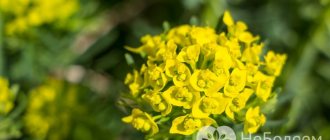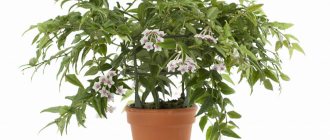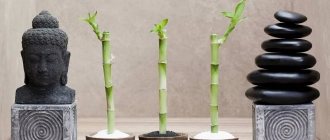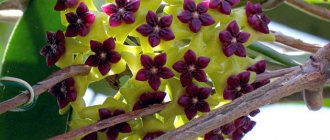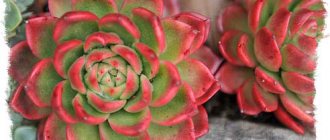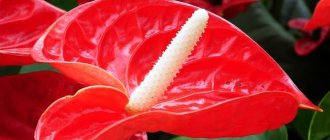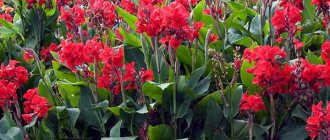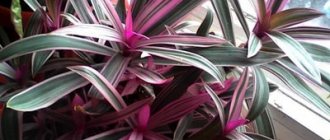Euphorbia: plant description
Euphorbia belongs to the Euphorbiaceae family; there are many species and subspecies of annual and perennial herbaceous plants, small trees and shrubs of this genus. The habitat of milkweed is observed in all areas of the continental and subtropical zone of the Earth. The plant received its name in honor of the Moorish physician Euphorbus, who was an expert in medicinal herbs and successfully used various plants for a variety of purposes. Thus, the juice of the Euphorbia plant was used by the doctor both as a medicine and as a poison, to eliminate unwanted people of the king, for whom he was in the service. The plant received its name in Russian because of the appearance of the juice that is released from Euphorbia when the stems or leaves are damaged.
Ways to combat milkweed
Euphorbia is a weed, so there are several methods for controlling it. They use traditional methods or modern drugs. Sometimes both methods are used.
It is best to start fighting the weed in early spring, when the leaves are just appearing on the plant. It is imperative to pull out the grass by the roots, without leaving even a single particle of it in the ground. If this is not done, the spurge will germinate in the soil again.
When fighting a plant, it is completely pulled out along with the roots.
The second method used to control field spurge grass is the use of herbicides. By combining these two methods together, you can completely get rid of weeds in your garden.
The benefits and harms of milkweed in the house
Euphorbia is a poisonous plant - its juice contains a large amount of substances that, if ingested, can cause severe poisoning. The juice of the plant can cause severe allergic reactions. Taking this into account, it is recommended to keep milkweed in homes where there are no pets or children, and replanting must be done with extreme caution.
All types of milkweed contain substances such as rubber, milky juice and resin. Despite the fact that scientists have not carried out a detailed biochemical analysis of the plant, it is known that the components of the milky juice include euphorbon and amorphous gum. Milkweed also contains coumarins (esters of hydroacids), flavonoids (polyphenolic compounds) and alkaloids (nitrogen-containing compounds).
Despite its poisonous properties, spurge is a medicinal plant - the roots, juice and herb are often used in the pharmaceutical industry as raw materials for medicines. The juice of the plant has an excellent diaphoretic, anti-inflammatory, diuretic and analgesic effect on the human body. Previously, in the absence of medicines, people treated animal and insect bites with milkweed juice, as well as long-term non-healing ulcers. Also, active enzymes in milkweed juice help cope with leukemia, providing an immunostimulating effect.
Tinctures from the roots of milkweed are used to treat skin diseases and stomach diseases, due to the content of large amounts of glycosides, tannins and saponins.
Folk signs and superstitions
There are signs and superstitions that apply to all types of milkweed, as well as special signs for individual species.
General signs for all species are most often associated with the correct or incorrect location of the plant:
- Euphorbia standing in the bedroom means quarrels and scandals between spouses; it will also prevent conception, and for bachelors it will prevent them from finding their other half.
- A flower standing near the front door protects the family from enemies and enemies.
- A plant standing in the office contributes to career advancement and receiving bonuses.
- Euphorbia standing in the bathroom or toilet is a sign of chronic diseases.
- Blooming spurge - good luck, good luck. At this time, it must be moved to the living room.
Some superstitions are associated with the disease and death of the plant:
- The milkweed began to rot for no reason - someone wishes harm to family members.
- The flower is sick - to problems, financial difficulties.
- The plant died - it saved people from misfortune, prevented trouble.
Signs for milkweed mile:
- helps protect the innocence of girls, protects from unworthy suitors and helps to find true female happiness;
- helps people with chronic diseases, strengthens the body's protective functions;
- lifts the mood.
Signs for white-veined milkweed:
- protects the house from dark forces;
- promotes resolution of conflict situations;
- protects from the evil eye and damage;
- brings prosperity, just like the money tree.
Video about the medicinal properties of milkweed
In addition to our article, we recommend that you watch a video about the healing properties of indoor milkweed.
Euphorbia is a popular houseplant today, despite the fact that it is considered poisonous and dangerous. He was loved by flower growers for his unpretentiousness and original shapes. A huge number of varieties of culture will allow everyone to choose according to their taste.
Euphorbia has about 2000 species of the family. Among them you can find succulent forms, shrubs, trees and leafy specimens. They all differ in the shape of leaves and stems.
However, there are no fundamental differences in caring for them. Care is simple. Even beginners in floriculture can grow it. Another peculiarity of the plant is that it secretes milky sap . The culture is often used in medicine. At the same time, it is poisonous .
Euphorbia is also called euphorbia . The plant received its name from the doctor Euphorbus, who was the first to discover the healing properties of the plant.
Most species have dense, fleshy stems and leaves. The stems may have thorns. At home, the species most often grown is called the Most Beautiful Euphorbia. This plant is also called poinsettia.
Also popular indoor milkweeds are Mila and Triangular.
Prerequisites for good flower growth
Poisonous indoor spurge causes intoxication when inadvertently or intentionally ingested. A negative reaction of the skin is manifested by burns, sometimes quite extensive. This happens because the juice of the flower is released in the air very quickly and in large quantities.
Ways of negative impact:
- Replanting, pruning an indoor flower without following the rules of caution;
- Work in the garden without using protective equipment;
- Preparation and treatment with medicinal substances based on indoor milkweed according to untested folk recipes;
- Overdose of infusions and decoctions;
- Accidental ingestion of leaves and internal flower fluid.
In children, poisoning and burns are a common reaction of the body when picking and playing with wild species of milkweed. The rate of development of intoxication depends on the physical condition of the body, the presence of chronic diseases and the amount of toxic substance consumed in food.
Caring for indoor spurge
Indoor spurge rarely causes difficulties for its owners. That's why he is called unpretentious. However, a number of rules will help in growing a beautiful and healthy flower. In order for a flower to look good, it must be looked after and replanted in time if necessary.
Humidity and watering
In summer, euphorbium needs regular and abundant watering . At the same time, you cannot overwater the plant; this is dangerous due to stagnation of water.
With the arrival of autumn, the amount of watering is reduced. In winter, the crop is watered only as needed. However, the soil should not be allowed to dry out too much. At the same time, some types of indoor euphorbias do not need winter watering at all.
Excess moisture at low indoor temperatures can lead to leaf drop and horse rot, which can lead to the death of the plant.
The crop does not need too humid air, but it does not like dry air either. Therefore, it is important to monitor moderate air humidity.
Watering milkweed
During hot periods, it is recommended to spray the leaves with water at room temperature and periodically ventilate the room. In winter, spraying is not necessary. However, the plant should be kept away from heating radiators and turned on heaters.
Temperature and lighting
Euphorbia prefers warmth . Therefore, it is necessary to keep the culture at an air temperature of 18 to 25 degrees.
In hot summer, it is advisable to take the plant out into the open air. A courtyard, open loggia or veranda will do. If the temperature drops to 15 degrees, it must be returned to the apartment.
Some varieties of the crop can tolerate very low temperatures of up to 4 degrees Celsius, but they also need good lighting.
The flower loves light . Some specimens do not mind basking in direct sunlight. Others prefer diffused light. The latter, for example, includes pounsettia.
The culture can also be kept in shaded areas. However, the leaves will not be as rich and bright as when growing in the sun.
Soil and fertilizers for euphorbia
For milkweed, you can purchase soil at specialized flower shops. Euphorbia soil is suitable for succulents or cacti . At the same time, experienced gardeners prefer to prepare the soil themselves.
Suitable soil for succulents for planting milkweed
For preparation you will need the following components:
- Turf land;
- Sand;
- Humus from leaves.
All components are taken in equal shares.
also necessary to make a drainage layer . You can use small pebbles, polystyrene foam or expanded clay as drainage. Drainage is necessary to ensure that moisture does not stagnate in the soil. This is fraught with rotting of the plant's root system.
Despite its general unpretentiousness, it still requires feeding. Typically, fertilizer is applied once every two weeks during vegetative growth. Fertilizers that can be used include fertilizers designed for succulent crops and cacti. For flowering milkweeds, it is necessary to apply fertilizers containing potassium.
No fertilizing is required in the autumn and winter.
Choosing a pot
You need to approach the choice of pot responsibly. It is advisable to choose clay pots . However, plastic containers will also work. The pot should be shallow, since the root system is poorly developed and is located near the surface of the soil.
When replanting a crop, select a pot slightly wider in diameter. A difference of 2-3 cm is enough.
It is very important that there are drainage holes at the bottom of the pot to drain excess moisture.
Euphorbia plant diseases and pests
Sometimes the owner has to face some problems. These usually occur due to improper care.
The most common:
- Leaf falling is a sign of phosphorus deficiency . To solve the problem, superphosphate is used as a top dressing;
- The falling of the lower leaves of the plant indicates insufficient watering ;
- Excessive watering coupled with low air temperature in the room leads to rotting of the stems In addition to increasing the temperature and reducing watering, the plant must be treated with fungicidal preparations;
- Darkening of the leaves is a consequence of lack of lighting ;
- Black and brown spots on leaves are a fungal disease . The plant must be immediately treated with a fungicidal preparation;
- If the leaves wither, then the flower needs to be watered more often and more abundantly.
The most common pests:
- Shchitovka;
- Mealybug;
- Spider mite;
- Root mealybug.
A sign of a flower being damaged by a mealybug is a white coating on the plant . A soap solution will help get rid of the pest. It wouldn’t hurt to add a little machine oil to it. Also, mealybug does not tolerate infusions of calendula and garlic.
The scale leaves white and brown spots on the leaves. It will have to be combated with the help of insecticidal preparations, for example Aktara.
Aktara will help control pests
A white coating on the underside of the leaves is a spider mite infestation . Wiping with a soapy solution helps;
root scale insects be determined when replanting white-veined milkweed. They need to be washed off with hot water. And after transplanting the renewed substrate, it is recommended to water the crop once a week with Aktara for a month.
Flower pruning at home
The purpose of pruning is to give the plant a beautiful shape and rejuvenation . Pruning is required either at the beginning of the growing season or in July, when the flowering period ends.
Initially, dry and old shoots are removed, and then the plant is given a beautiful shape.
In the year when pruning was done, euphorbia will not bloom. But next year it will be twice as abundant.
Reproduction
Indoor spurge can be propagated in three ways:
- Seeds;
- Cuttings;
- Dividing the bush.
You can collect seeds for propagation yourself. In this case, you will have to wrap the pods with seeds in a woven material in the form of a bag. This is necessary to prevent the seeds that have ripened in the pods from scattering. Such seeds can be stored for no more than one year. It is much better to sow fresh seeds.
To plant seeds, you will need soil containing peat and sand. Before sowing, it would be a good idea to heat the substrate in the oven. This will reduce the chance of developing an infection.
Before sowing the seeds, they must be soaked in water for 24 hours. Then they are sown in the soil in a moist state. The top of the crops must be covered with plastic film or glass to create a greenhouse effect.
Propagation by cuttings is carried out in the autumn. A shoot of a leaf node measuring about 10 cm is used as a cutting. All lower leaves must be removed from the shoot. Then the shoots are lowered into water to wash off the juice that the spurge secretes. The cut areas need to be treated with crushed coal.
Then the processed and dried shoots are placed in the ground in the form of sand. It is recommended to cover the seedlings with cut plastic bottles. It is not recommended to allow direct exposure to sunlight. The soil must be kept moist at all times.
Propagation of white-veined milkweed by dividing the bush is necessary during the dormant period of the crop. The milkweed is completely removed from the pot. The rhizome of the plant must be divided into several parts. It is necessary to ensure that there are no rotten roots on the rhizome. Then the finished shoots are planted in separate containers.
How to transplant
Basic rules for transplanting milkweed:
- The crop is replanted in the spring;
- A young plant must be replanted once a year during the period of active growth;
- Adult specimens only need to be replanted once every two years ;
- The pot for the transplanted flower should be slightly wider in diameter.
The plant should not be replanted unless necessary.
Contraindications to the use of plant-based products
The caustic nature of milkweed has also given rise to some contraindications to its use. The product cannot be used:
- people prone to allergic reactions;
- children under 12 years old;
- pregnant women;
- during lactation;
- people with individual intolerance to the components in the composition.
The use of milkweed is possible only after receiving official permission from a doctor. Please keep in mind that unexpected side effects may occur when using any traditional medicine, so self-medicate at your own risk.
What are the dangers, harms and benefits?
The plant is poisonous , so it must be used very carefully. If there are small children in the house, then spurge must be kept away from them - it can cause harm.
Why is it dangerous?
All types of milkweed are capable of secreting milky sap. It is very poisonous and dangerous . This juice is on the first line of all toxic products released by plant crops. Milky sap poses a danger not only to small children, but also to adults, people with allergies and pets.
Milkweed juice is extremely dangerous
Skin burn
Contact of harmful milky juice with the skin can cause severe burns and inflammation . The formation of rashes and allergic reactions is likely.
If the juice gets on the skin, it is recommended to thoroughly rinse the burned area with water and apply a piece of ice. It is also recommended to take an antihistamine (anti-allergy) drug.
Getting poisonous juice into the eyes
Getting milky juice into the eyes is very dangerous due to temporary or permanent blindness . If this has already happened, then you should immediately contact a specialist. Before seeing a doctor, you must rinse your eyes and apply antiallergic drops.
Kromhexal is suitable for these purposes. These drops are effective against redness. To prevent infection, it will not be superfluous to instill Albucid. You can also lubricate your eyelids with erythromycin ointment. In any case, you need to be extremely careful with the culture.
Drops for washing eyes in case of contact with milky juice
Getting into the mouth or inside
Milky sap is very dangerous in these cases. The following symptoms are likely:
- Dizziness;
- Nausea and vomiting;
- Breathing problems;
- Decreased body temperature;
- Swelling of the tongue;
- The appearance of seizures;
- Fainting conditions.
First aid
At the first signs of poisoning, you need to immediately call a specialist .
Before the doctor comes, it is recommended:
- Take activated carbon. For high-quality gastric lavage, it can be dissolved in sodium bicarbonate;
- If vomiting occurs, it is recommended to swallow pieces of ice;
- Use sodium or magnesium laxatives internally;
- Give an enema.
If an allergic reaction is observed, then you need to take an antihistamine.
Precautionary measures
In order to avoid poisoning or any other health problems, you must follow certain precautions regarding milkweed. Among them, experts primarily highlight the following important rules that are worth paying attention to:
- First of all, it is necessary to exclude possible contact of children with the plant.
- You should not prepare medicines based on milkweed yourself.
- In no case should you exceed the dosage of the drugs used, prepared on the basis of this plant.
- It is not recommended to change the treatment regimen indicated by a specialist using milkweed juice extract.
- All work with the plant should be carried out only when using personal protective equipment.
You need to understand that milkweed is a particularly dangerous plant that you should handle with the utmost caution.
If you adhere to the rules outlined above, you can protect yourself from adverse consequences. Even a simple burn from the juice of this plant can lead to very unpleasant burns and irritations. That is why it should be avoided whenever possible.
Beneficial features
Euphorbia has a number of beneficial properties. Because of this, the plant is often used in alternative medicine .
What are the benefits of milkweed?
Euphorbia can have a tonic and stimulating effect . It is also an effective means of cleansing blood vessels.
Herbal collection of milkweed
Euphorbia is effective for constipation and will be beneficial for diseases of the gastrointestinal tract. It also has an antitumor effect. The milky juice is often used to remove warts and calluses. Effective for cleansing the face of blemishes.
Lotions made from milkweed juice are effective in treating burns and boils .
Compound
The composition of milkweed includes the following components:
- Flavonoids;
- Saponins;
- Tannins;
- Ascorbic acid;
- Starch;
- Glycosides and resins.
Use in medicine
Euphorbia tincture is effective for blood cancer, for the treatment of metastatic tumors in cancer. The tincture is also extremely effective in boosting immunity.
To prepare the tincture you will need:
- 10 g of roots, crushed;
- 500 g vodka.
You need to use the tincture three times a day, 15 drops .
Euphorbia tincture
This recipe is also effective for impotence, uterine fibroids, stomach diseases, fungal infections, and whooping cough. Small doses of milkweed juice are effective for strengthening the body and rejuvenating.
The juice is very poisonous, so you should not ingest it without knowing the recipe.
are not used for medicinal purposes .
Milkweed roots are collected when the above-ground part of the crop withers. After washing and drying, the roots can be used to prepare decoctions and tinctures. Decoctions from the roots are effective against vomiting and diarrhea.
Euphorbia honey is a unique type of honey in its composition. It is a brown syrup. The brown color is due to the high iodine content. It is used to treat thyroid diseases, gastritis, insomnia and varicose veins.
Euphorbia is an original and ornamental plant. It is unpretentious. The most inexperienced gardener can afford to care for milkweed. Euphorbia secretes juice that is poisonous and dangerous to humans and animals. Moreover, the plant is often used in folk medicine.
Do you also have this stylish striped flower growing on your windowsill at home? This is white-veined spurge, indoor spurge. He is very handsome, captivating with his clear lines and proud posture. The gaze is sure to linger on it.
Preparation and storage
Collection season
The harvesting of milkweed root material is carried out in the fall, when the green parts of the plant have already withered and the growing season ends. When collecting plants, be sure to wear gloves, clothing that covers your body, and safety glasses.
Harvesting and drying
The roots, cleared of soil, are washed and wiped dry. As it dries, when the bark moves away from the root, it is strung on a dense thread. Hang raw materials to dry in well-ventilated areas with low humidity. It is not recommended to cut it in order to preserve the maximum amount of nutrients.
Storage rules
The dry root is stored in paper, canvas or containers with a tight lid. It retains its medicinal qualities for 3 years. Alcohol preparations based on milkweed have the same shelf life.
To properly collect flowers, you need to make sure that the plant being harvested is milkweed. After all, if you collect the wrong herb, it will not have the desired effect, and otherwise poisoning or other negative consequences may occur.
When harvesting the herb, spurge should not be allowed to include other medicinal plants. It is better to collect in areas where large quantities grow.
Folk recipes use the root, stems and juice. All these parts should be prepared separately. The juice is obtained from the fresh plant. Then it is evaporated in a water bath and placed in glass containers. Store blanks only in a cool place.
Euphorbia roots are harvested in early spring. This is done before the first leaves appear. You can also harvest them in late autumn, when the plant begins to wither. The dug up roots are cleaned of dirt, washed, treated with boiling water and dried at a temperature of 40 degrees.
The stems and grass of milkweed are collected before it blooms. After harvesting, the juice is squeezed out and the plant is laid out to dry.
Euphorbia flowers are harvested on rare occasions and then placed in places where the sun's rays do not reach. The finished raw materials are placed in glass jars for storage.
The dried plant can be stored for no more than 1 year. After this period, its medicinal properties are lost.
Almost all parts of milkweed have found their use in folk medicine. Raw materials can be purchased ready-made or prepared independently, taking into account some nuances:
- the collection should not contain components of other medicinal plants;
- It is better to collect spurge away from the urban environment and roadways;
- It is recommended to do this where grass grows in large quantities.
There are recipes for using almost all parts of the plant - root, stem, juice. It is recommended to prepare them separately.
Origin of milkweed.
The subtropics of Africa and America are considered the homeland of euphorbias. The plant is also found in the Canary Islands and Madagascar.
Euphorbia belongs to the succulent family, with about 2,000 species.
At home, they grow beautiful spurge (poinsettia), mile spurge, tiruccali spurge, fat spurge, multifaceted spurge, large-horned spurge and - the most popular indoor spurge - white-veined spurge. Just like yours, like mine on the windowsill.
White-veined milkweed (Euphorbia leuconeura) - one of the most popular among gardeners - has a ribbed, usually unbranched stem 40-60 cm high. From the bottom of the thickened trunk, the leaves usually fall off and remain at the top of the plant. For this reason, spurge is often called “palm tree”. The indoor spurge plant blooms quite often at home.
How can you prevent weeds from appearing?
You can remove spurge, but only if you use an agricultural machine. Such machines pull out weeds well and, in addition, sprinkle the ground with chemical solutions so that the weeds do not appear again. If the correct procedure is followed, Euphorbia Lozny can be removed within a few years.
Scientists are confident that when a machine cuts the Lozny weed, it cannot completely destroy it. Particles of roots remain in the ground, which eventually sprout again. Therefore, in order to completely remove the unwanted plant, it is worth studying all the details about the type of milkweed Lozny: how and where the weed grows and under what conditions, and also study photos of milkweed Lozny.
Caring for milkweed.
A very unpretentious plant, durable. Euphorbia requires almost no care. Very decorative. Watering is moderate, once a month is enough in winter. They love spraying. The optimal air temperature for milkweed in summer is 20-25 degrees, in winter - 12-16. Our house is equally warm in summer and winter. Plants grow without complications. I just water it quite often all winter so that the soil doesn’t have time to dry out. The plant loves sunlight very much, you can safely move it to the first line, closer to the glass. Of course, it is better to place it on a more illuminated windowsill. Flowering euphorbias are watered more often and be sure to be fed with potassium or complex fertilizer. Non-flowering milkweeds can be fed with cactus fertilizer.
Euphorbia grows well in a mixture of peat, sand, leaf soil, and turf soil. You can add brick chips to the sand. The mixture for seedlings is made up in equal proportions.
Propagated by seeds (most often by self-sowing) and shoots. After separation from the plant, it is advisable to dry the shoot before planting.
Euphorbia greatly appreciates care and responds gratefully to the love and warmth of its owners. Its slender bushes are pleasing to the eye.
Now the children have grown up and I got a new little milkweed - it still needs to grow and grow.
spurge is poisonous
Here it is, my baby white-veined milkweed.
Poisonous houseplant spurge.
Euphorbia - benefit or harm from this plant?
Be careful! Any milkweed is dangerous! Euphorbia is poisonous !!! It is imperative to instruct children how to handle this plant. If children are small or unruly or unpredictable, spurge should be placed higher up, out of reach. Euphorbia can cause considerable harm!!!
The fact is that these plants, when cut, broken, or simply separating a leaf, secrete a white juice - very unusual and quite attractive for research - such a white drop... This juice, if it gets on the skin or mucous membrane, causes a severe chemical burn. When I had small children, I simply threw out my gorgeous tall perennial milkweed - I was so scared by the information I read on the Internet. I then looked for the name of this plant and found an article that told how a teenage girl smeared the juice of this poisonous houseplant on her face. The consequences were some terrible - not just the skin peeled off and a new one appeared - some more permanent changes, even to the point of scarring. Overall, this is just another example that there are poisonous houseplants.
Selecting a location
As can be seen from the signs and Eastern philosophy, the correct choice of location is especially important for this flower.
In the office
If an indoor flower grows and develops well at home, it is recommended to grow a small amulet for yourself for work. It will help you earn the respect of your colleagues and superiors. It will also help to establish business contacts with partners.
At home
When you decide to get this flower, remember that you cannot place the flower:
- in the nursery;
- in the bathroom;
- in the toilet;
- in the bedroom.
Make sure that children and animals do not have access to it.
Where is the best place to place the plant?
The best place for a flower is in the hallway opposite the entrance , but not too close to the door. Here his protective power is manifested to a greater extent. But do not forget that the plant loves light. If there is not enough of it and there is a risk that the flower will wither there, you can move it to a window, preferably one that faces a busy street. And admire the blooming milkweed in the living room.
There should not be a mirror in front of the flower. It is believed that it draws all his energy onto itself.
Knowing all the properties of a flower, you can now decide for yourself whether you are ready to have it in your home and office. Indeed, despite its dangerous composition, from an energy point of view it is a very useful plant.
Euphorbia - benefits.
Euphorbia also has beneficial uses - it is a medicinal plant.
In pharmacies, milkweed is sold as a dietary supplement.
In Russia, milkweed has long been used to get rid of warts, age spots and dry calluses, i.e. for the treatment of skin diseases. Euphorbia is also used as a laxative to treat problems with the digestive system. In addition, this plant is also used in the treatment of inflammation of the oral cavity, in particular pulpitis. Used as an analgesic, antifungal, antiviral agent.
Of course, all these problems must be treated with caution, strictly following the recipe and remembering that there are poisonous plants in nature that can be beneficial if certain conditions are met. These are not completely harmless plants, so you need to be very careful!
You can read more about milkweed here and HERE.
Euphorbia is the only plant in the Euphorbiaceae family, but it has a huge variety of species and varieties. In the wild, this flower is represented by annual and perennial herbaceous species, subshrubs and low-growing trees. In its natural environment, it can be found in countries with tropical, subtropical and temperate climates.
Euphorbia gets its name from the thick milky sap that is released from its leaves and stems as a result of their damage. Many gardeners are interested in what the indoor spurge flower brings into the house?
Feng Shui meaning
Eastern philosophy believes that this indoor flower is capable of creating harmonious relationships in the family. It gives peace and relieves physical and mental stress. It also has a beneficial effect on the human skeletal system and protects against pain.
- The most beneficial effect is during flowering. It is recommended to place it in the living room at this time; after flowering, it must be moved to its usual place.
- Like any plant with thorns, this plant should not be kept in the bedroom so as not to cause discord between partners.
- It is also not recommended to place a flower in a nursery because of its negative impact on children.
- Placing a flower near water can lead to the development of various chronic diseases.
- When placed in front of the front door, the flower will protect from negative energy from the outside. Euphorbia is endowed with the ability to be a talisman for the whole family, which protects them outside the home - at school, at work, on a trip.
If you want to give someone a milkweed flower, then give it a young, immature plant. By giving a mature plant, you can give a person part of your well-being.
Planting and propagation
Reproduction of milkweed by seeds is a rather long and painstaking process. It is advisable to take material from female and male plants to obtain seeds in the future. The seeds also need to be scarified in advance - erase the protective shell with sandpaper. Euphorbia is sown in open ground in spring or autumn, and seedlings can be raised in winter.
Young shoots about 12 cm long take root immediately in moist soil. To do this, they need to be left in the greenhouse for about a month, and only then can they be transplanted to a permanent place. It is advisable that the distance between plants be at least 1 m.
At the end of spring, after the formation of strong young shoots, a tall bush of milkweed can be divided and planted. The procedure is repeated no more than once every 2-3 years and only for adult plants over 3 years old. Separation of young shoots is considered the most gentle and effective method of reproduction.
Photo: anatomyclub.su
Recipes and rules of use
Honey, how is it useful?
It has a specific taste and a very unusual aroma. It is tart and bitter. But, despite this, it retains its medicinal properties for a long time.
Used in the treatment of:
- sclerosis;
- rheumatism;
- anemia;
- gastritis.
It cleanses blood vessels, preventing the development of heart diseases.
Useful properties of this honey:
- memory improvement;
- increased muscle tone;
- strengthening the nervous system;
- hemoglobin production;
- replenishment of missing vitamins in the body.
Honey against insomnia
- 1 tbsp. l. milkweed honey;
- a glass of warm milk.
Add honey to milk, mix well until honey is completely dissolved. Drink after meals, no more than once a day.
Juice
I use it in the treatment of lichen, calluses on the feet, age spots or freckles.
From deprivation
Treat only with fresh juice . To do this, lubricate the affected areas of the skin for 20 minutes. Then wash off the juice with water.
For calluses on feet
- Generously coat the calluses with fresh milkweed juice.
- Wear socks made of natural fabric so that the juice is absorbed.
- In the morning, wash off the juice and use pumice.
- Do a course of 6-7 procedures at night.
Removing age spots and freckles
Use fresh milky juice. Lubricate the necessary areas with fresh juice. Then wash off and lubricate with fish oil.
Tea
The drink speeds up metabolism, removes excess fluid and cholesterol. Taken in small doses for cancerous tumors, for the treatment of the stomach, liver, cystitis, dysentery, hemorrhoids, and is used as a laxative.
- Pour 5 grams of dry grass into 500 ml of water.
- Boil for 10 minutes over low heat.
- Leave for 20 minutes and strain.
- Take 1 tbsp. spoon 20 minutes before meals.
Grass
Used for preparing tinctures. They are used for ulcers and inflammation in the lungs. They are able to strengthen the immune system and fight infections. Herbal tinctures will relieve diarrhea and cystitis.
- 1 tsp milkweed herbs pour 0.5 liters of boiling water.
- Leave for 30 minutes.
- Strain and use for baths.
Root
- Grind 5 grams of root.
- Fill with water (50 ml).
- Cook over low heat for 15 minutes.
- Leave for 2 hours.
- Use 1 tbsp every day before meals 2-3 times. spoon.
Tincture against warts
Take a teaspoon of dry herb.- Pour boiling water (half a liter).
- Leave for 30 minutes.
- Strain thoroughly.
Use to prepare baths for areas with warts.
You can also use this prepared remedy to treat lichen, eczema and fungal diseases.
Laxative decoction for the stomach
- Take 5 grams of milkweed root and add 500 ml of water.
- Simmer over low heat for 10 minutes.
Recommendation. Take 1 tablespoon orally three times before meals.
First aid
If a person is poisoned by milkweed juice, immediate medical attention is required. All the patient can do before the ambulance arrives is:
- Lie down on the bed and try to achieve maximum physical rest.
- Take 100 g of activated charcoal or a saline laxative to remove harmful compounds from the body.
- Drink alkaline mineral water, milk or jelly to reduce the negative effects of poisons on the body.
Hands stained with plant juice should not touch the face or other skin.
